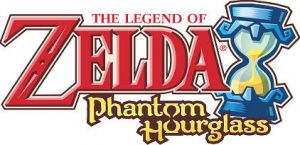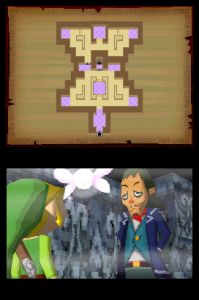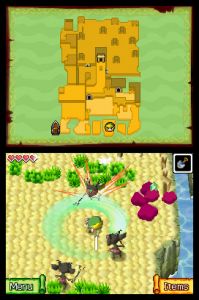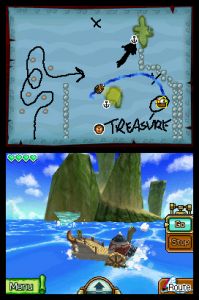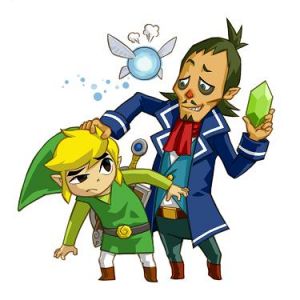Dear Reader:
GoNintendo "Start of day" thoughts - The Legend of Zelda: Phantom Hourglass review
I should never expect GoNintendo to let me do what I want. I should have known that the site is out to get me when I make promises! I had a deadline pop up last night for my next magazine article, so I had to devote the entire night to that. I swear, I’ve gone about 3 days with 2-3 hours sleep total. Video games CAN kill! The one thing I wouldn’t let slide by was my promise of a Phantom Hourglass review. I just finished it up now! I’ll be adding the pictures in just a few minutes.
It’s not exactly the easiest thing to take a game and turn it into a series. First off, you have to make a game that will gain a following. Planning out for sequels before the first title is even out the door is risky business. If you plan a game to span multiple sequels, and the premiere entry doesn’t sell well (Advent Rising, Beyond Good & Evil), that kind of kills the project right there. I mentioned a few games that came out within the last 5 years. Think about creating a series and making it last through every console generation. It’s nothing new for Nintendo, they have been doing it with all their AAA titles since their inception. The Legend of Zelda series is just one entry from Nintendo that has stood the test of time. Gamers have latched onto Link and his adventures. We have seen the series evolve through multiple 2d outings to eventually come into the world of 3D. Since Ocarina of Time, many have felt that the Zelda series has needed a kick in the pants. I tend to disagree with those people, but it’s obvious that Nintendo has taken those comments to heart. Not only does Phantom Hourglass reinvent the way we play a Zelda title, it brings innovations with it that are sure to influence the series as it continues on.I am not one for spoilers in reviews, so I will do my best to keep them to a minimum. I mean, the game has only been out for a few days now! Fear not, you can read on in safety. If I do have to make mention of something spoiler-ridden, I’ll be sure to make a note. If you consider the opening cutscene a spoiler, skip the next paragraph.
Phantom Hourglass not only looks like The Wind Waker, it is a direct sequel to that game. For those of you that were yearning to see what happens with Link after his Wind Waker adventures, this is the game that will quench your thirst. You’ll be picking up with Link just after he sets out on the high seas with Tetra and her gang of pirates. What else are pirates supposed to do but search for treasure? As the gang of thieves makes their way across the ocean, they come upon a ghost ship. While many of the crew are shaking in their boots, Tetra can’t resist the urge to climb aboard. What kind of rewards wait inside for her? Well, by the sound of her screams, the only thing she’s found is trouble. Link tries his best to board the ship and save Tetra, but to no avail. Just like that the ship disappears, and Link must find a way to save his friend.
The entire time I was playing Phantom Hourglass, I couldn’t help but be amazed. The first thought that you will have will probably be along the lines of , “how did they fit Wind Waker on the DS?”. It’s very true, this game will impress you right from the start. The visual style, while a little rough around the edges, does a fantastic job of matching what The Wind Waker pulled off. I usually go into discussing graphics at a later point in my reviews, but they have such an impact here that I felt it important to mention. Nintendo has proven that the hardware of the DS can be pushed to limits that we haven’t seen before. To fit this visual style, and this size of a world all on one tiny DS card is simply baffling to me. At first hearing that Nintendo was heading in this direction, I felt that the limitations of the DS would hurt the game. If anything, they have proven to me that the DS can do a lot more than I thought.
The biggest gripe everyone was having was that of the control scheme. When some very smart people pieced together the first trailers, they started to notice that Link seemed to be controlled via the stylus. Sure enough, Nintendo had decided to go with complete stylus control for the game. That’s an amazingly bold move to take with one of your AAA franchises. While I do trust Nintendo, I too was very skeptic that a decision like this could work out. There just seems to be so much that could go wrong. While some games have done a fantastic job with stylus input, a lot of them have more than a few “screw-up” moments. I didn’t want to have a new Zelda title that was ruined by controls.It takes all of about 10 minutes of playtime to realize that stylus input was a wonderful choice for this title. Making the input work this well and feel this good is something that I believe would take years and years to master. Nintendo’s expertise of their own hardware has come through, and proved that a Zelda title can definitely work with all stylus control. While the two input methods are completely different, I was having flashbacks of my first time controlling Super Mario 64. Just using the stylus to make Link run or walk (by placing the stylus closer/farther away from him) had me entertained. When you start to add in the stylus swipes and spins to use Link’s moves, that’s when it really comes together.
When I say that everything is controlled via the stylus, I mean absolutely everything. You don’t have to use the face buttons or dpad at any time in the game. While the traditional buttons can be used to bring up menus (if you want), all of these actions can be handled through the touch screen. Selecting the various weapons and tools is done by tapping the menu button, then the item you want. From there on out, it’s just a tap of Link or the surrounding area to use what you have in hand. There is also an icon in the upper-right hand corner that will actually place the item in Link’s hand. That way you aren’t running around trying to hit people with a shovel instead of your sword.
I also worried that fighting enemies would either be two easy, or very boring. I really have to stop second guessing Nintendo when it comes to AAA franchises. They aren’t going to put something out that is half-assed when it comes to their bread and butter franchises. The fighting scheme is so unique, it without a doubt is the most refreshing battle mechanics in a Zelda title for years. With Ocarina, Majora, Wind, and Twilight, everything was pretty much the same. You swing your sword via a button, and that’s about it. True, the Wii version let you waggle your heart out, and that was more fun…but not so revolutionary. Phantom Hourglass gives you a number of actions to attack an enemy, and you’ll be doing it in ways you’ve never done before. You can swipe towards an enemy to either lunge or swing your sword. You can also tap an enemy to leap at them with sword flying through the air. Drawing a circle around Link allows for him to unleash his spin move. Using all this while running around the screen makes for an intricate dance of touch screen action. If the stylus were a paintbrush and the DS screen a piece of paper, you would come out with a painting that would make Jackson Pollock proud.This new method of input for Link inevitably opens the door for all sorts of innovation in gameplay. This is once again an instance where I feel Phantom Hourglass really outshines the last few games. I absolutely loved Twilight Princess, but I honestly feel that Phantom Hourglass is more engaging. There is so much more in the way of new gameplay, new ideas, all while being firmly rooted in what made the Zelda series so popular today. I have seen reviewers both compliment the difficulty, as well as bash the game for being too easy. I must be really bad at games, because I side with the reviewers that applaud the difficulty. I found Twilight Princess to be a very easy game, having never died the entire time. While I wouldn’t call Phantom Hourglass a hard game by any means, I would say that it provides the most challenge, both in battles and puzzles, that the series has seen in years.
I knew that the touch screen would make for interesting puzzles. There just isn’t any way that Nintendo could have missed out on this. Phantom Hourglass will have you scribbling out all kinds of clues while you are on your adventure. You’ll be tracing locations of hidden items on your maps, marking down codes to help your through dungeons, and even jotting down personal notes to help your remember item placement. While the game does have a fair share of the traditional Zelda puzzles, you’ll be doing a lot of mind-benders that take advantage of everything the DS offers. Yes, that means you’ll be using the stylus, microphone, and even the two screens. Phantom Hourglass many more “wow” moments than any other Zelda game since A Link to the Past.
While it took a lot of guts for Nintendo to go the Wind Waker route on the Cube, it also took a lot to revisit it on the DS. One of the major portions of gameplay in WW was sailing around the game world. This turned out being one of the aspects that people either fell in love with, or absolutely hated. That’s not exactly what you want people to get out of one of your main gameplay mechanics. This time around Nintendo has given the sailing a huge overhaul, and I doubt that anyone that hated it the first time around would be upset with it this time. Now all you have to do is set a path by drawing a route on your map, and the boat will do the rest. You’ll get to blast away enemies while your sailing along, as well as jump over obstacles, and even stop to pick up treasure. This time around you even get to control the claw as it searches the depths of the ocean. There is simply so much more to do while sailing, you’ll be hard pressed to find time to be bored.You can also use those sailing portions to think about the game’s story. Phantom Hourglass is wonderfully written, and really shows the skills of the Nintendo Treehouse. They seem to really shine through when humor is an option, and that stays true with PH. Due to PH’s visual asthetic, there are a lot more instances where humor and light-hearted bits can be used. The Treehouse takes advantage of this, and goes for visual and verbal gags in a lot of the conversations. There is one particular portion of the game where a main character of the game, Linebeck, has an interaction with a statue. This is all while a serious conversation is going on with Link and another character. I will leave it at that as to not ruin the game, but trust me, it will have you chuckling. Even with all this humor, PH will get serious on you too. These bits don’t come out of nowhere, there is a nice flow to the storyline. There is definitely a lot of cut-scene action going on, which is always welcome in a Zelda game. Anything that gives us more details when it comes to story is just fine by me.
It’s not all wonderful though, I do have some complaints. Well, I actually only have a couple complaints, one of which I will get to here. Phantom Hourglass is one of those games that you don’t want to end. The entire time I played, I kept asking myself if this would be the last piece of the storyline, the last bit of puzzle before the final showdown. Unfortunately the game ends before you would like it to. I don’t know how long it would have to be to satisfy gamers, but 15 hours just doesn’t do it for me. The time spent in the game is fantastic, which is why it hurts so much when it ends. Getting a Twilight Princess playtime out of a portable Zelda would have been great, but I don’t know if that is possible. When you complain about length because of the game being so engaging, I guess that isn’t really a complaint at all.
The one area where I was let down was the music. I love the music in Zelda games, but Phantom Hourglass just didn’t seem to have too much of it. I am not saying that what is in the game is bad, it just isn’t as good as some stuff we have heard in the past. On one hand, there are some absolutely amazing songs. Linebeck’s theme is one of my favorites in a long time. Seriously, when I hear it I almost get a tear in my eye. The same goes for some of the tracks that revisit Wind Waker themes. Then, on the other hand, there are certain tracks that just don’t have much to them. Walking around in caves and dungeons gives you a very simplistic theme. These themes aren’t usually very intricate, but this time around they seem a bit too barren. You guys know that I am a big game music buff, so it’s hard for me to swallow when a Zelda title has some tracks that are forgettable.
Overall, I cannot recommend this game enough. It is, in every way, shape and form, a huge leap for the series. It breaks out of the shell we’ve seen for years now, and it tries new things. This is going to be a fantastic thing for both fans of the series, as well as the development team. Aonuma has already stated that working on Phantom Hourglass has given him new insight for more DS and Wii Zelda titles. We keep hearing that the next console Zelda is going to be unlike any other, and I am sure that some Phantom Hourglass themes are going to be responsible for that. With my only real gripe being some of the music, I can tell you that you should without a doubt pick up this game. If you are new to the series, or a long-time fan, you will definitely enjoy the game immensely. The GoNintendo warehouse has been filled with people playing the game. Just yesterday I was in a room with 3 people all playing. I was also in a room filled with smiles…the type of smile that only comes from a Zelda game.
